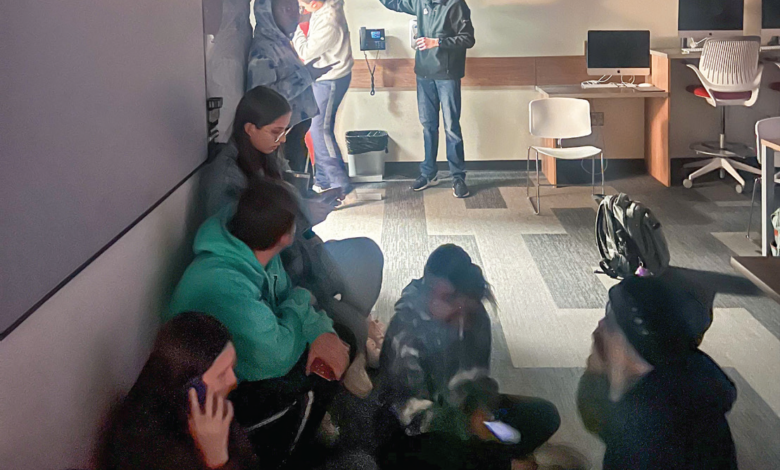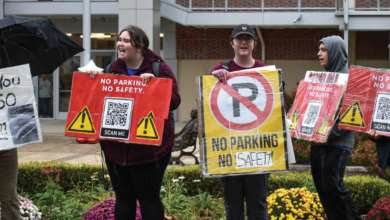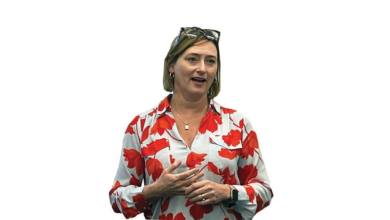
52 minutes: how Rider’s shelter-in-place transpired
By Amethyst Martinez and Kaitlyn McCormick
IN what can only be described as a moment of mass fear for those on Rider’s campus, a 52-minute shelter-in-place after an active shooter threat on April 3 has made faculty, students, and staff ponder the reality of events like these in educational settings, as well as question the preparedness of the university after the variation of responses during the lockdown.
The frightening event prompted the university to announce an immediate review, which could include safety upgrades to buildings and classrooms, according to Rider President Gregory Dell’Omo.
The first announcement
Just six minutes after many students started their 1:10 p.m. classes, Rider sent out a university-wide alert, notifying the community of a shelter-in-place. Many thought it was another possible weather-related warning after four tornadoes touched down in New Jersey over the weekend, prompting a shelter-in-place order on April 1 due to severe weather.
Texts and emails on April 3 instructed faculty, staff and students to stay or move inside and stay away from windows and doors.
The second alert, two minutes later, cautioned the university community of an undisclosed threat made to campus and informed them that Rider Public Safety and the Lawrence Police Department were investigating.
When the initial order went out, English professor Megan Titus knew that the odds of continuing to teach were low, but as she and the students in her Theories of Writing and Tutoring class continued to receive what she described as “cryptic” updates from the university’s alert system, she recalled wondering, “How real is this?”
At 1:21 p.m., the university disclosed that it had received a threat of a potential active shooter: “This is not a drill.”
Sophomore actor major Emily Porter Seigel, who uses they/them pronouns, was in an English class in the Fine Arts building at the time. They described the alert stating the active shooter threat as the moment it got “real” for them.
“I struggled to comprehend why they didn’t start with that,” said Seigel. “We were kind of shell shocked. We didn’t know what to do.”
By this time, multiple students reported taking precautions in their classrooms or dorm rooms, including closing blinds, locking doors and barricading doorways with tables and chairs. Many hid, reaching out to their family and friends, telling them they loved them. Other students described feelings of anxiety and distress, and some remembered classmates crying.
“It was surreal, and that’s really the only word for it,” said Siegel.
Titus described what was going through her mind as she eventually instructed students to sit together in the corner of her third-floor Fine Arts classroom, before then making the group decision to utilize the room’s tables and chairs as a barrier between the locked door and the people inside.
“I think I shut off the projector at that point, and then when it was clear that this was a situation that was not going to resolve itself quickly, and that it could be a very dangerous situation, that was when I kind of made the decision that we should move the tables just to be on the safe side,” Titus said.
Other students reported that some faculty members teaching their classes didn’t take the alerts seriously, and continued to teach.
Rachel Segierman, a junior arts and entertainment industries management major, said although her professor took the shelter-in-place seriously, she described seeing Instagram posts from students in continuing classes.
“People [were] saying, ‘How would you expect me to literally sit here and concentrate and take notes when there could be something dangerous on campus and we’re not being protected,”’ said Segierman. “I mean, how do you expect us to sit here and still learn and concentrate?”
During the lockdown, Segierman also said that a student was pulled out of her ethics classroom and questioned by police officers.
She said that police stated that the student was not in trouble, but wanted to question him.
Segierman said, “We’re all looking at each other like, ‘What the heck is happening?’”
Other students were in different locations across the university, such as dorm rooms, bathrooms, and public spaces, but fear was present regardless of their locations.
Aileen Pujols, a sophomore acting major, hid underneath her bed in her dorm room alone for the almost hour-long shelter-in-place. During the lockdown, Pujols reached out to friends and tried to explain to her family, whose first language is Spanish, the situation she was in.
“Having to explain that to your parents in a different language, while also receiving this information and trying to figure out what to do with it…was really hard for that hour,” said Pujols. “Of course, everyone understands the words active shooter.”
Sophomore acting major Kelly Chavez-Menjinvar was taking a shower in her dorm building at the time of the first alert, and came back to her room, hiding with her roommate until the lockdown was over.
“I was just thinking the worst, because you never know now, unfortunately, in this country,” said Chavez-Menjinvar.
Mass shootings have become a hot-button issue across the United States, especially in educational settings. One of the latest, a shooting in Nashville, Tennessee, that took the lives of three children and three adults in a school, happened just 7 days prior to Rider’s active shooter threat.
“It’s never real until it happens,” said Siegel. “I go to school every day knowing that there is a chance that I could die, quite frankly.”
Brianna Ortega, the sister of a Rider student, called the university to try and get more information about the threat after hearing that her sister, junior elementary education major Megan Ortega, was sheltering in place in the Fine Arts building.
“I was getting ready to drive over there,” Brianna Ortega said, recalling that she was trying to find updates online. She said that the person who answered the phone was also under shelter-in-place orders, and instructed her that the Rider alert system would give her and her sister the most updated information.
Another update came at 1:31 p.m., informing the community that the Lawrence Police Department and Rider Public Safety were investigating the threat.
At this point, students remained where they were: in classes, dorms, or any shelter they could find across campus.
Junior musical theater major Nicole Duffy said that her class ultimately found itself locked in the windowless dressing rooms of the Spitz Theater in the Fine Arts building.
“It took me a while…for the fear to hit me, and I did definitely cry,” Duffy said. “We were holding hands. I was very thankful that I was in a space with people that I all knew.”
The next alert came seven minutes later at 1:38 p.m., stating that the Main and South Entrances of campus were closed to entering and exiting traffic, the shelter-in-place still ongoing.
“I feel like all the information from the university had been horrifically vague,” said Siegel.
Students and faculty continued to follow the alert system and police scanners, waiting for results and relying on information from friends in other buildings.
According to John Bochanski, department chair of Rider’s Department of Computer Science and Physics, a police scanner mentioned Hill Hall during the shelter-in-place. Multiple students reported a high police presence at Hill Hall as well.
At 1:53 p.m., the Rider alert system informed that there was no confirmed active shooter, but faculty were instructed not to dismiss classes and the campus to continue to shelter in place.
The shelter-in-place was formally canceled 15 minutes later at 2:08 p.m., with no active threat to campus.
Seigel described the moments after leaving their classroom, being met with a “gorgeous sunny day” when they walked out the doors of the building.
“I look around and the people around me are pretending that nothing has happened,” said Seigel. “I felt crazy.”
Duffy, like many, decided to leave campus as soon as she was able, following the all-clear.
“There was a huge line to get off campus because people just wanted to be nowhere near here,” she said.
Updates in the aftermath
The university published a follow-up to the shelter-in-place order: “We are currently gathering more information to share with our community as soon as possible,” it read.
Later in the day, the Lawrence Police Department determined the active shooter threat to be a “swatting event.” Swatting is a prank call to emergency services in an attempt to draw a large armed police presence to a specific location.
At 4:21 p.m., Rider Provost DonnaJean Fredeen sent a message to faculty via email, thanking them for protecting and keeping students calm during the shelter-in-place.
While Fredeen said classes would be able to meet for the remainder of the evening, she urged faculty to “be as flexible as possible in regards to [their] attendance policy” in the case that students may have opted to not attend.
According to a universitywide email from the Office of the President following the shelter-in-place, “Even though it was determined that there was no credible threat to campus, we understand the need to shelter in place can cause feelings of anxiety and stress. Please know that assistance is available for our students, faculty and staff.”
The next day, Dell’Omo sent an email to all students, faculty, staff and parents, assuring the community that the university was taking a “thoughtful and collaborative approach” to its campuswide after-action review, assessing what worked well and where improvements could be made.
The email mentioned that the university was “immediately assembling” a team to review “every aspect” of the prior day’s events, and the group’s related actions could involve “mandatory training, safety upgrades for buildings and classrooms, enhanced communication tools and more.”
“We have also heard from members of our community expressing a variety of concerns that should be evaluated,” Dell’Omo wrote. On social media platforms, numerous students and parents expressed concern or anger about classroom doors that couldn’t be locked from inside or whose large window-walls offered no place to hide.
Re-living the lockdown
During and after the order, many students took to social media to share their thoughts and views from their classrooms while sheltering in place. Many photos showed doors blocked by tables and chairs, students huddled together in dark corners and behind desks on the floor.
As classes continued the next day, many expressed still feeling shaken by the shelter-in-place and the fear they had experienced.
Titus opted to offer her April 4 night class online, saying that she didn’t feel safe being on campus at night, but also didn’t want her students to have to grapple with the decision of whether or not to come to class given the circumstances.
Pujols said, “Going back to class and everything resuming as normal was super difficult, because it felt like the world just keeps on turning, even though a really scary thing happened.”


